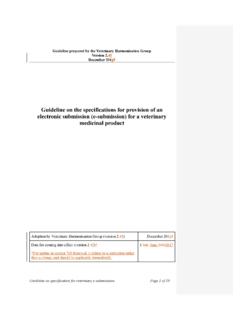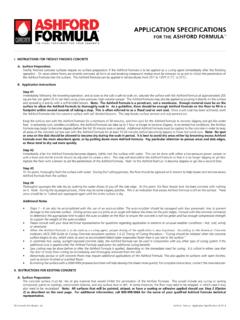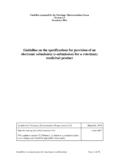Transcription of MULTISOURCE (GENERIC) PHARMACEUTICAL PRODUCTS: …
1 Working document July 2014 Document for comment 1 2 MULTISOURCE ( generic ) PHARMACEUTICAL 3 PRODUCTS: GUIDELINES ON REGISTRATION 4 REQUIREMENTS TO ESTABLISH 5 INTERCHANGEABILITY. REVISION 6 (JULY 2014) 7 8 REVISED DRAFT FOR COMMENT 9 10 11 World Health Organization 2014 12 All rights reserved. 13 This draft is intended for a restricted audience only, the individuals and organizations having received this draft. 14 The draft may not be reviewed, abstracted, quoted, reproduced, transmitted, distributed, translated or adapted, in part or 15 in whole, in any form or by any means outside these individuals and organizations (including the organizations' 16 concerned staff and member organizations) without the permission of the World Health Organization. The draft should 17 not be displayed on any website. 18 Please send any request for permission to: 19 Dr Sabine Kopp, Group Lead, Medicines Quality Assurance, Technologies, Standards and Norms, Department of 20 Essential Medicines and Health Products, World Health Organization, CH-1211 Geneva 27, Switzerland.
2 Fax: (41-22) 21 791 4730; email: 22 The designations employed and the presentation of the material in this draft do not imply the expression of any opinion 23 whatsoever on the part of the World Health Organization concerning the legal status of any country, territory, city or 24 area or of its authorities, or concerning the delimitation of its frontiers or boundaries. Dotted lines on maps represent 25 approximate border lines for which there may not yet be full agreement. 26 The mention of specific companies or of certain manufacturers products does not imply that they are endorsed or 27 recommended by the World Health Organization in preference to others of a similar nature that are not mentioned. 28 Errors and omissions excepted, the names of proprietary products are distinguished by initial capital letters. 29 All reasonable precautions have been taken by the World Health Organization to verify the information contained in 30 this draft.
3 However, the printed material is being distributed without warranty of any kind, either expressed or implied. 31 The responsibility for the interpretation and use of the material lies with the reader. In no event shall the World Health 32 Organization be liable for damages arising from its use. 33 This draft does not necessarily represent the decisions or the stated policy of the World Health Organization. 34 35 Should you have any comments on the attached text, please send these to: Dr Sabine Kopp, Group Lead, Medicines Quality Assurance, Technologies, Standards and Norms, World Health Organization, 1211 Geneva 27, Switzerland; email: fax: (+41 22) 791 4730 and to Ms Marie Gaspard by 15 September 2014. Working documents are sent out electronically and they will also be placed on the Medicines website for comment. If you do not already receive directly our draft guidelines please let us have your email address (to and we will add it to our electronic mailing list.)
4 Working document page 2 SCHEDULE FOR THE PROPOSED ADOPTION PROCESS OF DOCUMENT : 36 MULTISOURCE ( generic ) PHARMACEUTICAL PRODUCTS: GUIDELINES ON 37 REGISTRATION REQUIREMENTS TO ESTABLISH INTERCHANGEABILITY. 38 REVISION 39 40 41 42 Preliminary feedback for chapters to be revised and discussion during informal consultation with experts and prequalification assessors July 2013 Presentation of the outcome of the above consultation to forty-eighth meeting of the WHO Expert Committee on Specifications for PHARMACEUTICAL Preparations October 2013 Revision of guidelines developed by Mr J. Gordon with input from the Prequalification Team and Professor Dressman, WHO Collaborating Centre on Bioequivalence Testing of Medicines, Frankfurt/Main, Germany April 2014 Circulation for comment May June 2014 Collation of comments 2 July 2014 Discussion during an informal consultation held together with the Prequalification Assessment Team 6 7 July 2014 Circulation of revised working document July 2014 Collation of comments and review by expert group September 2014 Presentation to forty-ninth meeting of the WHO Expert Committee on Specifications for PHARMACEUTICAL Preparations October 2014 Further follow-up action as required.
5 Working document page 3 BACKGROUND 43 Over the course of time and especially in view of the implementation of the existing 44 guidelines1 the users have indicated that there was a need to review and update certain 45 requirements. The forty-eighth meeting of the World Health Organization (WHO) Expert 46 Committee on Specifications for PHARMACEUTICAL Products discussed this and included the 47 following passage in its report (extract from the forty-eighth report): 48 WHO published MULTISOURCE ( generic ) PHARMACEUTICAL products: Guidelines on 49 registration requirements to establish interchangeability in 2006. In preparation 50 for the revision of the WHO document, the Expert Committee received a report 51 that compared the WHO guidance on interchangeability with that of the European 52 Medicines Agency (EMA) and the United States Food and Drug Administration 53 (US-FDA). Guidance issues proposed for revision were highlighted. It was stated 54 that a first draft of the revision would be available in due course.
6 The Committee 55 was also asked to consider to what extent WHO guidance should extend to non-56 biological complex drugs (NBCDs). The Committee agreed that guidance for this 57 new group of products might be relevant if they were included in the EML and 58 asked the Secretariat to look into it. 59 In connection with the revision of these guidelines, the following related guidance texts 60 are also under review and update: 61 Proposal to waive in vivo bioequivalence requirements for WHO Model List of 62 Essential Medicines immediate-release, solid oral dosage forms 63 Annex 8, WHO Technical Report Series 937, 2006; 64 65 1 MULTISOURCE ( generic ) PHARMACEUTICAL products: guidelines on registration requirements to establish interchangeability. In: WHO Expert Committee on Specifications for PHARMACEUTICAL Products. Fortieth report. World Health Organization, Geneva. WHO Technical Report Series. No. 937, Annex 7, 2006.
7 Working document page 4 Additional guidance for organizations performing in vivo bioequivalence studies 66 Annex 9, WHO Technical Report Series 937, 2006; 67 68 Guidance on the selection of comparator PHARMACEUTICAL products for equivalence 69 assessment of interchangeable MULTISOURCE ( generic ) products 70 Annex 11, WHO Technical Report Series 902, 2002; 71 72 Guidance on the selection of PHARMACEUTICAL products for assessment of 73 interchangeable MULTISOURCE ( generic ) products (working document ); 74 75 List of international comparator products (working document ). 76 77 Working document page 5 MULTISOURCE ( generic ) PHARMACEUTICAL PRODUCTS: GUIDELINES 78 ON REGISTRATION REQUIREMENTS TO ESTABLISH 79 INTERCHANGEABILITY. REVISION 80 Background 81 1. Introduction 82 2. Glossary 83 3. Documentation of equivalence for marketing authorization 84 4. When equivalence studies are not necessary 85 5. When equivalence studies are necessary and types of studies required 86 In vivo studies 87 In vitro studies 88 6.
8 In vivo equivalence studies in humans 89 General considerations 90 Provisions for studies in humans 91 Justification of human bioequivalence studies 92 Selection of investigators 93 Study protocol 94 7. Pharmacokinetic comparative bioavailability (bioequivalence) studies in humans 95 Design of pharmacokinetic studies 96 Alternative study designs for studies in patients 97 Considerations for active PHARMACEUTICAL ingredients with long 98 elimination half-lives 99 Considerations for multiple-dose studies 100 Considerations for modified-release products 101 Subjects 102 Number of subjects 103 Drop-outs and withdrawals 104 Exclusion of subject data 105 Selection of subjects 106 Monitoring the health of subjects during the study 107 Considerations for genetic phenotyping 108 Working document page 6 Investigational product 109 MULTISOURCE PHARMACEUTICAL product 110 Choice of comparator product 111 Study conduct 112 Selection of strength 113 Study standardization 114 Co-administration of food and fluid with the dose 115 Wash-out interval 116 Sampling times 117 Sample fluids and their collection 118
9 Parameters to be assessed 119 Studies of metabolites 120 Measurement of individual enantiomers 121 Quantification of active PHARMACEUTICAL ingredient 122 Statistical analysis 123 Two-stage sequential design 124 Acceptance ranges 125 Reporting of results 126 Special considerations 127 Fixed-dose combination products 128 Clinically important variations in bioavailability 129 Highly variable active PHARMACEUTICAL ingredients 130 8. Pharmacodynamic studies 131 9. Clinical trials 132 10. In vitro equivalence testing 133 In vitro equivalence testing in the context of the Biopharmaceutics 134 Classification System 135 Biopharmaceutics Classification System 136 Determination of dissolution characteristics of MULTISOURCE 137 products in consideration of a biowaiver based on the 138 Biopharmaceutics Classification System 139 Working document page 7 Qualification for a biowaiver based on the Biopharmaceutics Classification 140 System 141 Dissolution criteria for biowaivers based on the Biopharmaceutics 142 Classification System according to the properties of active 143 PHARMACEUTICAL ingredients 144 In vitro equivalence testing based on dose-proportionality of formulations 145 Proportional formulations 146 Qualification for biowaivers based on dose-proportionality of 147 formulations 148 Dissolution profile comparison for biowaivers based on dose- 149
10 Proportionality of formulations 150 In vitro equivalence testing for non-oral dosage forms 151 10. 5 In vitro equivalence testing for scale-up and post-approval changes 152 References 153 Annex. Recommendations for conducting and assessing comparative dissolution profiles 154 155 1. INTRODUCTION 156 157 These guidelines are intended to provide recommendations to regulatory authorities when 158 defining requirements for approval of MULTISOURCE ( generic ) PHARMACEUTICAL products in 159 their respective countries. The guidance provides appropriate in vivo and in vitro 160 requirements to assure interchangeability of the MULTISOURCE product without 161 compromising the safety, quality and efficacy of the PHARMACEUTICAL product. 162 163 National regulatory authorities (NRA) should ensure that all PHARMACEUTICAL products 164 subject to their control conform to acceptable standards of safety, efficacy and quality, 165 and that all premises and practices employed in the manufacture, storage and distribution 166 of these products comply with good manufacturing practice (GMP) standards so as to 167 ensure the continued conformity of the products with these requirements until they are 168 delivered to the end-user.



















